Kobalt-M Satellite Overview
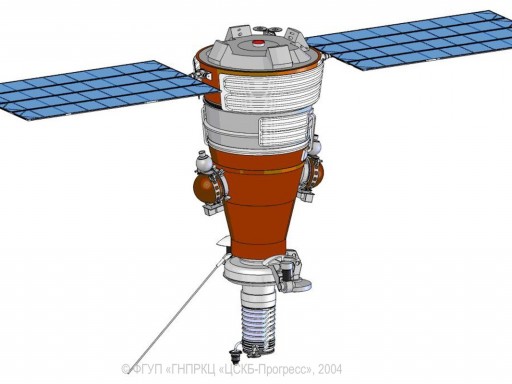
Kobalt-M satellites are large optical reconnaissance satellites that are based on the Yantar-4K2M satellite system. The satellite uses an optical imager and physical film that is returned to Earth using three re-entry vehicles followed by post-flight analysis of the images. Although the use of electro-optical spacecraft downlinking digital images to the ground has a number of advantages, the film-return system is considered a very reliable source of high-resolution images that in some aspects still provide advantages in image quality over the digital systems.
In addition to the Kobalt-M film-return satellites, Russia operates a series of electro-optical spacecraft for civilian use as well as the Persona military reconnaissance spacecraft that are capable of acquiring and downlinking high-resolution images.
The new Bars spacecraft, first launched in 2014, feature a similar architecture as Kobalt, but use digital imaging and downlink of acquired footage to eventually replace the film-return spacecraft in the coming years. However, Russian officials indicated that one Kobalt satellite would be launched per year until the reliability of the new systems have been proven to ensure a continuous supply of satellite images.
The development of the Yantar film-return reconnaissance satellites was initiated in 1964 to eventually replace the Zenit reconnaissance spacecraft that performed missions of eight to 15 days and achieved resolutions on 1 to 2 meters. Overall, more than 500 Zenit film-return missions were flown between 1961 and 1994
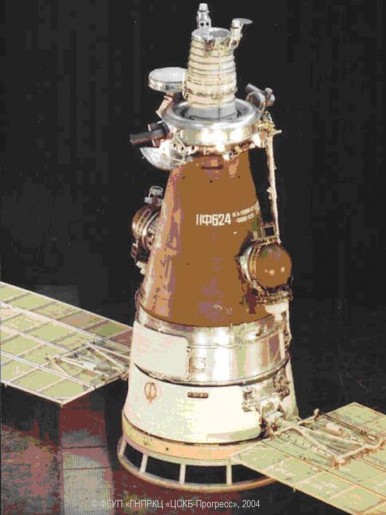
Spacecraft known as Yantar-1 were planned to provide images for reconnaissance of larger areas and cartography while the Yantar-2 satellites would carry high-resolution imagers. An number of other Yantar satellites were planned and conceptualized but never realized such as ultra-high resolution spacecraft and cartography satellites. The development of the Yantar series proceeded slowly as manned missions were given priority in the 1960s and early 70s.
The development of the improved Yantar-2K satellite series was initiated in 1967 working towards a launch in 1969, but the first Yantar launch was delayed until 1974 when the Yantar-2K series also known as Feniks first flew. The very first Yantar launch in May 1974 ended in failure and the satellite could first be tested in December 1974 after a successful launch and orbital insertion. The flight lasted just 12 days after which the return vehicle landed and brought back the photos that were taken in orbit. A total of seven test launches of Yantar-2K were performed by 1978 before the system was declared operational and flew 23 more missions until 1983.
Due to increasing demand for satellite images and more capable spacecraft, the development of Yantar-4K was initiated in 1977 to build satellites that could stay in orbit for one and a half months. The Yantar-4K1 spacecraft also known as Oktan flew 12 missions from 1979 to 1983.
Featuring an upgraded camera system, Yantar-4K2 – known under the Codename Kobalt – made its first launch in 1981. Kobalt satellites were slightly modified and improved over time and their operational missions were extended to 60 days in 1984 followed by an extension to up to three months in 1996 and another extension to flights of 120 days in 1997. Overall, 82 Kobalt satellites were launched from 1981 to 2002.
Alongside the Yantar-4K satellites, development of the Yantar-1KFT satellites began under the codename Kometa and Siluet. These satellites were used for cartography, covering large areas at a lower resolution. The first Yantar-1KFT launch took place in 1981 and a total of 21 Yantar-1KFT satellites were launched until 2005.
The development of Yantar-4KS was initiated in the late 70s to realize the first electro-optical system based on the existing optical system of Yantar.
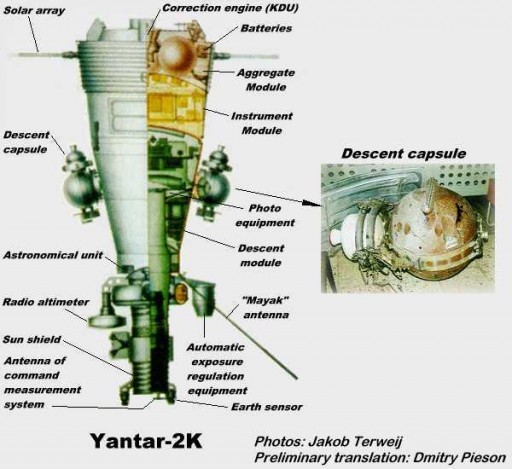
4KS spacecraft were also called Terilen and were capable of downlinking acquired images in the visible and infrared spectral range via ground stations or data relay satellites. 15 such satellites were launched from 1982 to 1990 and provided images with a resolution of around 2 meters.
An improved version, Yantar-4KS1M or Neman, was first launched in 1991 and could operate for about 250 days, increasing the typical mission duration of the previous satellite generation. Nine Yantar-4KS1M satellites were launched from 1991 to 2000.
In 2004, the maiden launch of the Kobalt-M satellite took place, featuring upgraded optical systems and a modernized satellite platform but still relying on the film-return technique. Beginning in 2006, one Kobalt-M satellite was launched each year, the most recent being Kosmos-2480 on May 17, 2012. Typical mission durations for the earlier Kobalt-M satellites were on the order of 75 to 100 days while the more recent flights were over 100 days long. The 2012 Kobalt-M mission had a duration of 130 days.
Kobalt-M was developed by TsSKB Progress of Samara and the satellite is being built by OAO Arsenal, St Petersburg. Overall, the spacecraft has a launch mass of approximately 6,600 Kilograms and uses three modules – a Service Module, an Instrument Module and a Payload Module that contains the imaging payload. The spacecraft is about 6.3 meters in length and 2.7 meters in diameter featuring two 6-meter long solar arrays for power generation. Each of the deployable arrays consists of four segments.
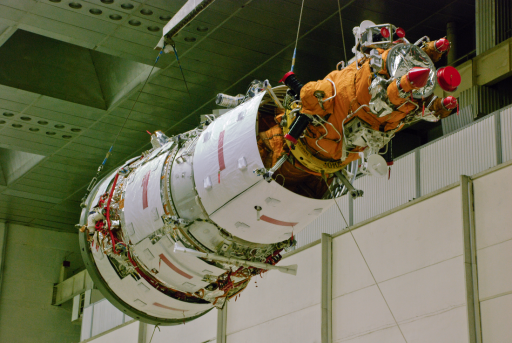
The Service Module has a length of around 1.2 meters and contains the satellite’s propulsion system that uses up to 900 Kilograms of Unsymmetrical Dimethylhydrazine and Nitrogen Tetroxide Propellants with Helium as pressurant gas. The propulsion system consists of a main propulsion unit used for impulse burns and a series of low-thrust engines for vehicle control. The main engine of the vehicle provides 2.94 Kilonewtons of thrust and the reaction control engines have thrust levels from 5 to 100 Newtons. Using its propulsion system, Kobalt-M can perform frequent orbital maneuvers. Operating in a high-drag environment, the spacecraft has to maintain its orbit to avoid re-entry before the end of the planned mission. Also, propulsive maneuvers are used to adjust the vehicle’s orbit to set up favorable imaging passes over chosen targets.
The Instrumentation Module has a length of approximately one meter and contains all support systems of the satellite including electrical systems, batteries, navigation equipment featuring a gyroscope unit and two Star Trackers, the vehicle’s communication system for command uplink and telemetry downlink and the attitude control system of the spacecraft.
The Payload Module accommodates the optical imaging system of the spacecraft. No details on the camera system of Kobalt-M are known, however, there are estimations that earlier Yantar satellites had an aperture diameter of 0.6 meters with a focal length of 3 to 4 meters.
The optical module included as shield for stray and solar light rejection and an aperture cover that was only opened for imaging sessions. Kobalt-M can achieve a ground resolution of up to 0.3 meters when lowering its Perigee for imaging sessions.
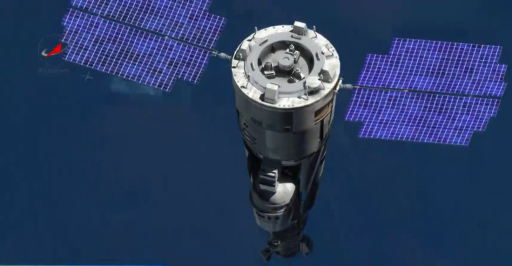
The exposed films are returned to Earth via two re-entry capsules that are installed on the external side structure of the spacecraft. Using mechanical equipment, the exposed films are moved into the entry capsule before it is separated and uses retrorockets to conduct a targeted deorbit burn for a landing on Russian territory. The entry capsules have a diameter of less than one meter and are spherical in shape featuring a heat shield to survive the re-entry environment and a parachute system for a safe return of the films. The entry capsules use spin-stabilization during orbital flight and re-entry. The entry capsules are separated when needed and can return at any point in the mission based on the amount of acquired images and the need of returning images of certain targets.
In addition to the two re-entry vehicles, the main payload section of the Kobalt-M satellite returns to Earth at the end of the mission carrying the remaining exposed films. Once having conducted its deorbit burn, the modules of the Kobalt satellite separate and the main return capsule conducts a targeted re-entry and landing in Russia.
The return vehicle is equipped with its own attitude control system featuring several thrusters, a parachute system and soft landing engines using solid propellant to cushion the impact of the vehicle.
The returned films are then processed by the Center of Space Reconnaissance. The images are used by the Russian Ministry of Defence and the Main Intelligence Directorate of the Chief of Staff.
Kobalt-M satellites operate in Low Earth Orbits at an altitude of less than 300 Kilometers an an inclination of 63 to 67 degrees, however, some of the recent Kobalt missions used inclinations of 82 degrees to cover a larger portion of Earth. Over the course of a typical mission, Kobalt-M performs a series of orbital adjustment maneuvers that can lower the Perigee to as low as 150 Kilometers for imaging sessions to improve the resolution of the images.
